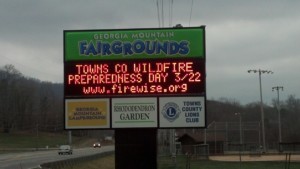
GFC Guest blog by Michael Courey, Towns Co. Firewise Coalition leader
Many people long to leave hectic, high intensity lifestyles in large metropolitan urban areas and retreat to calmer, less densely population communities. While living in rural, forested environments is peaceful, it comes with some trade-offs and lessons for homeowners.
The areas in which homes are nestled into natural settings is termed the “Wildland Urban Interface,” or “WUI” (pronounced WOO’-ee) for short. People living in these areas are at increased risk for forest fires.
Forest fires are normal events in nature. They are beneficial in that they clear away debris and open up landscapes for animals to forage. However, as societies push into WUI’s, preventing the occurrence of fire becomes critical.
Wildfires are often caused by lightning strikes, but far too many are sparked by humans. Escaped debris burning is Georgia’s number one cause of wildfire. Campfires, outdoor cooking, even hot lawn equipment on a pile of dry tinder can ignite a fire. Add brisk winds to the equation and it’s easy to see how one flying ember can set off a dangerous fire.
Regardless of the cause of the forest fire, its only discriminating factor is that it must have fuel to burn and conditions that support combustion. The forest is the perfect setting for that support, and when people live within or near this perfect environment for fire, the risk of loss is considerable.
The Firewise USA program is designed to lessen (mitigate) the loss of life and property to wildfire. It serves as a valuable guide to helping WUI residents learn to live safely and mitigate against the devastating effects of wildfire.
Fortunately, there are a number of common-sense actions that individuals, and communities as a whole, can take. Home landscape and construction changes can be made to actually encourage fires to move around our homes, rather than through them. The Firewise program provides a wealth of information, free of cost, to enable residents to mitigate their risk of fire disaster.
Granted, these measures are not a guarantee against loss, and a firestorm pushing burning embers at 40 mph will be mostly uncontrollable. However, against the ground-crawling burn that is feeding off the forest floor deadfall of leaves and tree debris, the mitigation efforts taken in advance to establish a “defensible space” around a home does offer a considerable burn deterrent.
There are other facets of the Firewise USA Program, such as a “Community Coalition” and the “Ready, Set, Go” initiative, which offer advantages in preparing for a forest fire.
For those who live in this WUI space, it is not a matter of if a fire will impact our lives, but when, and whether we lose our home or become a resident casualty must be taken seriously in advance.
For more information about Firewise, visit https://gatrees.org/fire-prevention-suppression/firewise-usa-program/.

